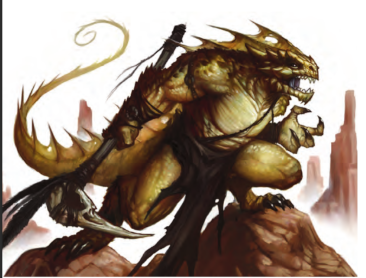Posts
-
Let's Read the 4e Dark Sun Creature Catalog: Tembo

A tembo, who looks like a giant scaled rat with sabertooth fangs. This post is part of a series! Click here to see the rest.
The Lore
If our previous entry was kind of vague about whether tareks were a product of the genocidal “Cleansing Wars” in Athas’ distant past, this one is pretty categorical. Tembos are bioengineered terror weapons, created using magic most foul for the purposes of facilitating genocide.
The “Champions” of that time (which unknown to most are the sorcerer-kings of today) created them to sneak upon the homes of their opponents, and take from them those they loved most. In addition to their stealthy forms and sharp fangs, they received a limited ability to blend with shadows, the power to bite someone in the soul, and a sophisticated intellect that is entirely devoted to finding new ways of fulfilling their purpose in crueler ways.
They have survived as a species to this day, roaming mainly through the western wastelands of the Tyr region, but they have been sighted elsewhere too. There’s no one to give them specific targets any more, so they choose their victims themselves, for food and fun.
Confirmation that a tembo is targetting a settlement is one of the only things that will immediately end any infighting and other disagreements and make its whole population unite against the threat. Everyone hates these things more than they hate each other, which is saying something in Athas.
How exactly these attacks happen vary with the creature’s whims, as well as with what it judges to be the most effective tactic for a given situation. Sometimes they stay hidden and let their deadly magical aura slowly kill the population, and sometimes they tear people apart in broad daylight.
The Numbers
Tembos are Medium Aberrant Magical Beasts and Level 6 Solo Skirmishers with 280 HP. Their Killing Presence acts as an aura (2) that deals 5 necrotic damage to anyone who starts their turn inside. When the tembo is bloodied, its second aura kicks in. Tainted Wounds (aura 5) halves any HP recovery from healing effects for those inside.
As a solo, the tembo has Double Actions, meaning it rolls initiative twice and takes full turns in both counts. And finally, it’s Immovable, being completely immune to any kind of forced movement, and getting a free save against being knocked prone.
The monster’s main attack is a Bite that damages, inflicts a -2 attack penalty for a turn, and serves as a carrier for the Unspeakable Violation secondary attack. This targets Fortitude, and on a hit eats a healing surge and doubles the damage from Killing Presence against that target for a turn. Fortunately, it has Recharge 6+, so it doesn’t happen with every bite.
Its attack it’s likely to use the most is a Raking Assault, which deals the same damage as the bite then lets the Tembo shift 4 squares and use the bite. So that’s two or three attacks for the price of one, with the creature being able to do this two times per round.
Its camouflage powers take two forms: Blending (encounter) is a move action that makes the tembo invisible for a turn or until its next attack. And Shadow Evasion (recharge when first bloodied) is a reaction that triggers when it’s hit by a melee or ranged attack, letting it shift 4 squares and become insubstantial for a turn.
Having two full turns per round can actually make Blending last even less, so it’s not something a tembo will use to lie in wait for a long time. It will instead rely on mundane stealth for this. Then it will charge in, use as many Raking Assault flurries as it can, and combine Shadow Evasion with Blending to escape from sight, only coming back to attack when its enemies’ guards are down. Its ability to delete healing surges makes such long-term harassment tactics even more effective, since it will obviously attack you in your sleep and stop you from taking a long rest. Fighting the creature to the finish in a single encounter will require preventing its escape somehow.
Encounters and Final Impressions
What a horrible, horrible monster.
Tembos are almost always found alone. As mentioned above, everyone hates these things. They will sometimes join together in small packs, but these end up breaking apart pretty soon because they suck at organizing themselves.
-
Let's Read the 4e Dark Sun Creature Catalog: Tarek

A tarek raider. He's a large, muscular, blue-skinned humanoid with a bald head, large pointy ears, and large pointy teeth. This post is part of a series! Click here to see the rest.
We’re back to using the s-word for this one, though it only appears once.
The Lore
According to the book, legends tell that “an entity of mad destruction” created the tareks in the very distant past to serve as “instruments of murder”. I guess this means that they were created as bioweapons for the genocidal wars of the Red Age, which would explain why they’re so strong and tough. In any case, their earth priests helped them revolt against their masters and attain independence.
In our narrative present, tareks live in isolated communities in Athas’ hilly and moutainous regions. They’re intensely isolationist and xenophobic, so most of the contact they have with other humanoids is when they raid any of their communities that might be located too near to tarek territory.
While they seemingly hate everyone, they are “sworn enemies of the gith”. Like all particularly strong humanoid species, they’re popular targets for slavers because they do well at the arena. It’s no wonder most revolts in Athas seem to start there…
The Numbers
Tareks are Medium Natural Humanoids with a ground speed of 6. Their signature trait is Deathless Warrior, which lets them roll a save when they hit 0 HP. If they pass, they only drop at the end of their next turn, and can act normally until them. They speak Common and Giant, and are Unaligned by default.
The book recommends adding additional varieties of tarek by taking orc stat blocks and replacing their bonus charge speed and Warrior’s Surge with Deathless Warrior. So I guess they’re explicitly Darker and Sunnier orcs.
Tarek Raider
Raiders are Level 3 Soldiers with 49 HP. They’re disciplined and try to stick together in a fight even if scattered by forced movement. Their Tarek Squad Tactics give them Combat Advantage against anyone adjacent to at least one other Tarek.
A raider is usually armed with a Bone Heartpick whose attacks damage, slide 1 square, and mark for a turn on a hit. If someone decides to ignore the mark, their Dangerous Aggression gives them a free attack against the offender, and if that hits the target is also immobilized (save ends).
Tarek Earth Shaman
Earth shamans are Level 4 Controllers with the Leader tag. They fight much like Earthbenders from the Avatar shows.
Their melee attacks use Fists of Stone which target Fortitude, damage on a hit and slide 3 squares as an effect. They can also use a spell named Clutching Stone (close blast 3 vs. Fort, recharge 5+) that does the same damage, knocks targets prone, and restrains them (save ends). And their ultimate technique is Tide of Stone (close blast 5 vs. Ref, recharges when first bloodied), which deals heavy damage and knocks prone on a hit. Allies caught in the blast can instead shift 3 squares as an effect.
Encounters and Final Impressions
Tareks will only buddy up with other tareks and whatever domesticated beasts they might train. You will only find them in Mixed Groups of People if they’re enslaved.
As seen above, they like to stick close to each other in fights, and the book also mentions they like the same focused fire tactics that tend to be described as optimal for PCs. In other words, if they can they’ll pick a particularly vulnerable target and focus their attacks there until the target is dead before moving on to the next.
-
Let's Read the 4e Dark Sun Creature Catalog: Ssurran

A ssurran, which looks like a lizard persion with tan scales, standing on a desert ridge and armed with a bone pick. This post is part of a series! Click here to see the rest.
I believe this entry confirms that different monster entries in the Catalog are written by different authors, because its description of Athasian lizardfolk is as even-handed and respectful as the one for muls was racist, and they’re not even playable by default!
The Lore
As mentioned above, ssurrans are Athasian lizardfolk. They’re as adapted to the desert wastes as their relatives from other worlds are to swamps. Like all other humanoids in Athas, their daily goal is survival.
Ssurrans (also known as “sandscale lizardfolk”) organize in nomadic tribes made up of several family groups and a number of reptilian beasts that serve the usual purposes from hauling cargo to helping in fights. They hunt, forage, and sometimes raid while on the move.
Ssurran raids on settled communities are downright merciful when compared to most others described so far. They allow the inhabitants to flee and only kill those who try to fight back. Then they steal every usable good they can carry and move away, taking care to erase their tracks and lay some false trails to deter pursuers.
The Numbers
Ssurrans are Medium Natural Humanoids with the Reptile and Lizardfolk tags. They have a ground speed of 6 with Earth Walk, and speak Draconic. While this entry only has two stat blocks, it does outright say that you can take any standard lizardfolk from other books and replace Swamp Walk with Earth Walk to get a sandscale version. You can also apply one of the monster themes found in the back half of the book (and which we’ll see eventually).
Ssurran Shaman
Sandscales have a long tradition of worshipping the sun and related primal spirits. A shaman’s duties also include preserving their tribe’s oral history and culture.
Your typical ssurran shaman is a Level 3 Controller with 47 HP. They fight with a Spear that damages and pushes 1 square on a hit, and can cast at-will Sun Curses (ranged 5 vs. Reflex) that deal fire damage and daze for a turn. Their Treacherous Spirit spell (ranged 5 vs. Will, recharge on a miss) dominates the target (save ends).
Despite their low-level, ssurran shamans are pretty dangerous and are likely to be an unfortunate PC party’s first introduction to the Dazed and Dominated conditions.
Ssurran Hunter
These make up the bulk of any ssurran scout, hunting, or raiding party. They’re Level 4 Minion Skirmishers that fight with picks that deal a little extra damage to enemies granting Combat Advantage. If an enemy hits one of their adjacent allies, the hunter can use Sidestep as a reaction to shift 1 square.
Encounters and Final Impressions
Ssurran tribes tend to stick together. Lone lizardfolk will either be outcasts, or the last survivors of their tribes. Sometimes, slavers kidnap their young for sale as “exotic merchandise”, so they might be found among enslaved guards or gladiators.
I really like the way they were described in the book - my text here is barely paraphrased. Simply by describing these lizardfolk as people, it already allows me to imagine a bunch of situations where they’re potential oposition but where things can still be solved by means other than murder. They also make great potential allies in many other scenarios, because even when a group of ssurrans is not nice there will likely be someone much worse nearby.
-
Let's Read the 4e Dark Sun Creature Catalog: Spider

A large spider made of translucent crystal. This post is part of a series! Click here to see the rest.
The Lore
Dark Sun is still a D&D setting. Therefore it needs giant spiders.
Athasian giant spiders behave much like their kin from other worlds. They prefer locations that afford them plenty of hiding and ambush spots like caves, deep valleys, and so on. While neither of the varieties presented here can spin webs fast enought to do so during combat, they still might cover entire chasms or large passages in them as they wait for more prey to wander by.
Crystal Spider
One of the prettiest monsters in the Tablelands, its carapace is made of actual crystal. Aside from the usual venomous bite and their razor-sharp appendages, crystal spiders also have smome power over light and are capable of radiant attacks.
Crystal Spiders are Large Natural Beasts and Level 4 Lurkers with 39 HP. Their ground and Spider Climb speeds are both 8, and they have Tremorsense 10 to detect people touching their webs. Their carapace makes gives them Resist 5 Radiant, but also Vulnerable 5 Thunder.
It also gives them the Gleaming Carapace trait, which gives them concealment until the end of their next turn any time they move more than 5 squares in the same action. I guess glare is a major problem with fighting crystal spiders on their home turf.
Their basic attack is a decently damaging Razor Leg (melee 2), and they can use a bite (melee 1 vs. Fort) against a target that cannot see them, dealing both immediate and 10 ongoing poison damage (save ends).
Crystal spiders could achieve that unseen state by moving more than 5 squares and hiding, but they have a couple of shortcuts in the form of their light-bending powers. Radiant Agony (close burst 2 vs. Fort) pushes its targets 3 squares and blinds them for a turn, recharging whenever no one is blinded or when the spider hits with its bite. Brilliant Ray (ranged 10 vs. Ref, recharge 5+) does a good chunk of radiant damage and blinds for a turn.
Crystalline Web
Any place where crystal spiders hunt will be filled with these razor sharp traps. They’re statted up as Level 4 Obstacles, each consisting of a patch of webbing 4x4 squares in size, stretched between two surfaces. They’re semi-transparent and require a DC 14 Perception check to notice in bright light, or 19 in dim light.
When a character enters a web square, the web attacks their Reflex, doing immediate and ongoing 5 physical damage on a hit (save ends). Hit or miss, the target’s movement ends and it gets pushed back to the last square it occupied.
A character can use Acrobatics (DC 14) to move through a webbed square, or they can attack the web and deplete its 25 HP to destroy it.
An elite version of this trap has 50 HP instead, and deals increased damage when it catches someone. In either case, good luck dodging these in dim light or while blinded by the crystal spiders who made them!
The book doesn’t explicily state it, but I would say crystal spiders should be immune to the effects of their own webs.
White Widow
White Widows are a bigger, stronger, and stealthier relative of the crystal spider. While they lack the ability to fire lasers, they still have some control over light and like to blind their prey. They’re Huge Natural Beasts and Level 15 Lurkers with 110 HP, resist 10 poison and radiant, and Vulnerable 10 thunder. Their speed and senses are the same as a crystal spider.
The reason white widows like to blind their prey is that they deal 15 ongoing “poison and radiant” damage (save ends) when they hit blinded targets with any attack. Yes, this means their venom is deadly even to things that are normally resistant or immune to poison. This trait is named Combat Advantage but that name is misleading, as it only grants its benefit against blinded targets.
The spider’s bite is a basic attack that also deals “poison and radiant” damage, but it’s not going to be used on its own unless conditions are right.
Instead of biting it can turtle up and use its Reflective Defense, which gives it a +5 bonus to all defenses for a turn and blinds anyone who misses them with an attack during that time. The Scuttling Attack maneuver (recharge 5+) lets it shift half its speed, bite someone, and shift the other half.
When hit by a fire, radiant or lightning attack (in other words, anything shiny) the spider can react with the Venomous Dawn attack, enhancing and reflecting that light back at its attackers. This is a Close Burst 5 vs. Reflex, deals radiant damage, and blinds (save ends).
Widow’s Web
Any battle against white widows will happen in a place filled with these. They’re not sharp like a crystal spider’s, but they’re still quite dangerous as Level 15 Obstacle traps.
White widow web patches are 10x10 squares in size and require a DC 22 Perception check to notice in dim light, but are automatically visible in bright light. The web attacks the Reflex of anyone who enters one of its squares, and restrains on a hit (save ends). Webbed squares are also difficult terrain to anyone without the Spider Climb ability.
Characters can avoid the trap by leaping over webbed terrain, or destroy the web by dealing 40 HP of damage to it. An elite version has double the HP and can take two opportunity attacks per turn, which is useful in case two or more targets get pushed into it in the same action.
Encounters and Final Impressions
You’ll mostly commonly be meeting these spiders singly or in pairs, with the rest of the encounter balance being made up of web patches. They can appear anywhere you would expect to find the standard varieties of D&D giant spider, which also exist in Athas because why wouldn’t they?
-
Let's Read the 4e Dark Sun Creature Catalog: Silt Runner

A silt-runner, which looks like a little purple lizard dude running very fast while carrying a spear. This post is part of a series! Click here to see the rest.
The Lore
Silt Runners are basically Athasian Kobolds. While they’re not described as “savage”, all of the usual kobold slander is also present here. They’re small reptilian humanoids who are intensely xenophobic and whose entire society is based on raiding other humanoid settlements. They wield stolen weapons and wear bits of clothing and body parts from their victims as trophies, eating the rest.
The main differences here seem to be that Silt Runners are more related to ssurrans (Athasian lizardfolk) than to dragons, and that they’re much more nomadic and aggressive. They gather in warrens linked by tunnels and located near their prospective raid targets, but are quick to abandon those hideouts when their targets attempt a retaliatory strike.
For some reason, silt runners hate the fey, and have been known to ignore far more vulnerable targets in favor of attacking well-protected elves and eladrin.
The Numbers
Silt Runners are low-level and fit right alongside kobolds as Small Natural Humanoids with the Reptile tag. But while standard kobolds have the Shifty trait, Silt Runners have Silt Runner Swarm, which causes any enemy adjacent to 2 or more silt runners to take 2 damage at the start of their turn. They also have low-light vision and a surprisingly zippy ground speed of 7.
Silt Runner Darter
These Level 1 Artillery menaces have 25 HP and wield blowguns with an assortment of darts. They keep to the edges of the battle and shoot whoever they can.
The Blowgun deals standard damage and has Range 12, so they can keep a fair distance away from the scrum. Some of their shots will be with Poisoned Darts (recharge 5+), which deal heavy poison damage and immobilize (save ends). As an aftereffect, the target is slowed (save ends). A miss deals half damage and slows for a turn, which is very strong for a rechargeable attack.
If engaged in melee, they can defend themselves with Wooden Daggers, but those are nothing to write home about.
Silt Runner Rager
Ragers are Level 1 Brutes with 34 HP. The Bone Spears they wield look comically large, but have Reach 2 and are very effective. In addition to standard attacks, they can use them in Brutal Spear maneuvers that deal increased damage and recharge when first bloodied, or in a Penetrating Spear maneuver that also deals increased damage and makes the target Vulnerable 5 to all damage for a turn.
Silt Runner Inciter
This one is a Level 2 Controller with the Leader tag and 38 HP. If they had a PC class, they would be Ardents, as they have psionic powers capable of causing strong emotions on their allies - fury, in this case.
Inciters can make a decent show of themselves in melee with their Bone Swords, and they can attack at range with a Psionic Detonation (area 1 within 10, recharge 6+) that deals force damage and creates a zone that lasts for a turn and is difficult terrain for enemies.
They can also Incite Fury in a close blast 5, causing each ally within the blast to shift 1 square and make a free basic attack either before or after the shift. When first bloodied, they can do that again as a free action, and Incite Fury recharges, which means they could use this power a total of three times per encounter.
Inciters want to drop that difficult terrain zone as soon as possible and then have their allies swarm the PCs caught inside so that Incite Fury is maximally effective.
Encounters and Final Impressions
Silt Runners mostly stick together, but will sometimes cooperate with other reptilian humanoids, and keep reptilian beasts as pets.
So yeah, they’re Athasian Kobolds. You can easily take standard kobold stat blocks, increase their speed to 7, and replace Shifty with Silt Runner Swarm to increase your collection of silt runner stat blocks.
subscribe via RSS